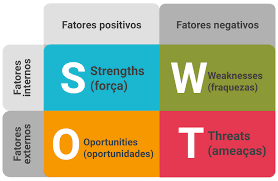Advertisements
Discovering your strengths and weaknesses is a crucial step for any person or company seeking success. In a world of fierce competition, understanding where you excel and where you need to improve can make the difference between leading the market or falling behind. This is where SWOT analysis comes in, a strategic tool that allows you to identify not only your internal capabilities but also the opportunities and threats presented by the environment. In this post, we'll explore how to conduct an effective SWOT analysis and how you can use it to enhance your strategy.
With a SWOT analysis, you can assess your internal strengths, such as unique skills, valuable resources, or competitive advantages that distinguish you from others. It's also essential to recognize your weaknesses—those areas where you need to improve so they don't become obstacles to your success. This process of introspection and evaluation will give you a clearer view of your current position and help you chart a path forward with confidence.
Advertisements
But it's not just about looking inward. A SWOT analysis also guides you through the external landscape, identifying opportunities you can seize and threats you must mitigate. From emerging market trends to regulatory changes, understanding your environment will allow you to adapt and react proactively. By the end of this journey, you'll be equipped with a solid strategic plan that will allow you to confidently face challenges and seize every opportunity that arises. Get ready to take your strategy to the next level!

Understanding SWOT Analysis
A SWOT analysis is a strategic tool that allows individuals and organizations to identify their strengths, weaknesses, opportunities, and threats. This analysis is critical to developing an effective strategy, as it provides a clear view of the internal and external elements that can impact success. The clarity gained through a SWOT analysis not only aids in strategic planning but also promotes a more conscious and proactive approach to addressing challenges.
Advertisements
To conduct an effective SWOT analysis, it is essential to involve different stakeholders, as diverse perspectives can enrich the process. By considering both internal and external factors, a SWOT analysis offers a comprehensive framework that facilitates informed decision-making. By embarking on this process, one can discover not only areas for improvement but also new opportunities for growth and development.
Identifying Your Strengths
Strengths are the positive attributes that a person or organization possesses and that can be leveraged to achieve goals. These can include special skills, unique resources, or an advantageous market position. To identify your strengths, it's important to conduct an honest self-assessment and consider what factors differentiate you from others.
Some examples of strengths can be:
- A highly trained and motivated team
- A solid reputation in the market
- Advanced technological capabilities
Reflecting on your strengths allows you to use them as a solid foundation upon which to build your strategy. It's vital to recognize and celebrate these attributes, as they are the driving force that can fuel your future success. Don't underestimate the power of your strengths: they are at the heart of your strategy.
Recognizing Your Weaknesses
Identifying weaknesses is crucial, as these are internal factors that can impede progress or the achievement of goals. Recognizing them can be challenging, as it often involves admitting areas where improvement is needed. However, it is a necessary step for growth and continuous improvement.
Weaknesses may include:
- Lack of experience in certain areas
- Financial limitations
- Excessive dependence on a customer or supplier
When addressing your weaknesses, it's essential to take a constructive approach and develop strategies to mitigate them. This could include additional training, diversifying your customer base, or implementing new technologies. By transforming weaknesses into areas of focus, you can turn potential obstacles into opportunities for development.
Exploring Opportunities
Opportunities are external factors that can be leveraged to improve the position of a person or organization. These can arise from market changes, technological advances, or social trends. To identify opportunities, it is necessary to be aware of external dynamics and be willing to adapt to new circumstances.
Examples of opportunities include:
- Expansion into new markets
- Strategic collaborations
- Adoption of innovative technologies
Seizing opportunities requires agility and a proactive approach. By being alert to emerging trends and continually assessing the external environment, you can position yourself to capitalize on these opportunities and strengthen your strategy. Remember that opportunities can be fleeting, so act quickly and decisively.
Facing Threats
Threats are external factors that could jeopardize the success of a person or organization. Identifying and preparing for them is essential to minimizing their impact. Threats can arise from a variety of sources, such as intense competition, regulatory changes, or economic instability.
Some common threats are:
- Increasing competition in the market
- Changes in legal regulations
- Economic fluctuations
To effectively manage threats, it is important to develop mitigation strategies that include diversification, adaptation, and innovation. By being prepared for the unexpected, you can reduce the impact of threats and protect your interests. Remember that anticipation and planning are key to overcoming any challenge that may arise.
Integrating SWOT Analysis into your Strategy
Once you've conducted a thorough SWOT analysis, the next step is to integrate it into your overall strategy. This analysis provides you with a roadmap that highlights where you can maximize your strengths, address your weaknesses, take advantage of opportunities, and mitigate threats. By doing so, you can create a strategy that's aligned with your objectives and tailored to your environment.
Some ways to integrate SWOT analysis are:
- Set clear goals based on your strengths
- Develop action plans to improve weak areas
- Identify strategic alliances to take advantage of opportunities
- Create contingencies to address potential threats
A SWOT analysis isn't a one-time exercise, but rather an ongoing process that should be reviewed and adjusted regularly. By keeping your analysis up-to-date, you can respond more effectively to changes in the environment and ensure your strategy remains relevant and effective.
Conclusion
In conclusion, understanding your strengths and weaknesses through a SWOT analysis not only gives you a clear view of your current position but also prepares you to face future challenges with confidence. By identifying opportunities, you can align your resources to make the most of them, thus driving growth and innovation within your organization. On the other hand, by recognizing potential threats, you'll be better prepared to mitigate them or even turn them into favorable opportunities.
A SWOT analysis is an essential tool for any successful business strategy. Not only does it help you improve the efficiency and effectiveness of your operations, but it also fosters an environment of continuous reflection and constant improvement. By implementing this analysis regularly, you ensure that your strategy is always aligned with the changing market environment.
Furthermore, this strategic approach is not only applicable in the business world but can also be used on a personal level for professional and personal development.




